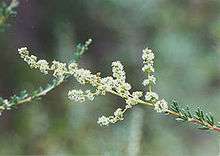Adenostoma fasciculatum
| Adenostoma fasciculatum | |
|---|---|
 | |
| Scientific classification | |
| Kingdom: | Plantae |
| (unranked): | Angiosperms |
| (unranked): | Eudicots |
| (unranked): | Rosids |
| Order: | Rosales |
| Family: | Rosaceae |
| Genus: | Adenostoma |
| Species: | A. fasciculatum |
| Binomial name | |
| Adenostoma fasciculatum Hook. & Arn.[1] | |
Adenostoma fasciculatum (chamise or greasewood) is a flowering plant native to Oregon, Nevada, California, and northern Baja California. This shrub is one of the most widespread plants of the chaparral biome.
Description
Adenostoma fasciculatum is an evergreen shrub growing to 4m tall, with dry-looking stick-like branches. The leaves are small, 4–10 mm long[2] and 1mm broad with a pointed apex, and sprout in clusters from the branches. These clusters are known as fascicles, and give the species its Latin name. The leaves are shiny with flammable oils, especially in warmer weather. The branches terminate in bunches of white tubular flowers five mm diameter, with five petals and long stamens. The fruit is a dry achene.
The oily leaves give rise to the common name greasewood.
Varieties
There are two varieties which differ from each other in minor characters; they are not accepted as distinct by all authors:
- A. f. var. fasciculatum - Leaves 5-10 mm, apex sharp; shoots hairless.
- A. f. var. obtusifolium - Leaves 4-6 mm, apex blunt; shoots slightly hairy.
Ecology
It is very drought tolerant and adaptable, with the ability to grow in nutrient-poor, barren soil and on dry, rocky outcrops. It can be found in serpentine soils, which are generally inhospitable to most plants, as well as in slate, sand, clay, and gravel soils. Chaparral habitats are known for their fierce periodical wildfires, and like other chaparral flora, chamise dries out, burns, and recovers quickly to thrive once again. It is a plant that controls erosion well, sprouting from ground level in low basal crowns that remain after fires, preventing the bare soil from being washed away.
Chamise grows in dense, monotypic stands that cover the dry hills of coastal California. These thickets of chamise are sometimes called chamissal. The species also gives its name to a specific chaparral (i.e., Adenostoma fasciculatum chaparral) dominated by A. fasciculatum, according to C.Michael Hogan. In this chaparral type toyon may also be a co-dominant.[3]
See also
Notes
References
- Jepson Flora Project: Adenostoma fasciculatum (1993)
- USDA Plants Profile (2008)
- C. Michael Hogan, (2008) Toyon (Heteromeles arbutifolia), GlobalTwitcher, ed. N. Stromberg
External links
| Wikimedia Commons has media related to Adenostoma fasciculatum. |